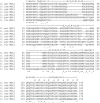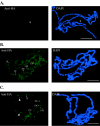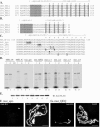The amino-terminal region of Drosophila MSL1 contains basic, glycine-rich, and leucine zipper-like motifs that promote X chromosome binding, self-association, and MSL2 binding, respectively
- PMID: 16199870
- PMCID: PMC1265775
- DOI: 10.1128/MCB.25.20.8913-8924.2005
The amino-terminal region of Drosophila MSL1 contains basic, glycine-rich, and leucine zipper-like motifs that promote X chromosome binding, self-association, and MSL2 binding, respectively
Abstract
In Drosophila melanogaster, X chromosome dosage compensation is achieved by doubling the transcription of most X-linked genes. The male-specific lethal (MSL) complex is required for this process and binds to hundreds of sites on the male X chromosome. The MSL1 protein is essential for X chromosome binding and serves as a central scaffold for MSL complex assembly. We find that the amino-terminal region of MSL1 binds to hundreds of sites on the X chromosome in normal males but only to approximately 30 high-affinity sites in the absence of endogenous MSL1. Binding to the high-affinity sites requires a basic motif at the amino terminus that is conserved among Drosophila species. X chromosome binding also requires a conserved leucine zipper-like motif that binds to MSL2. A glycine-rich motif between the basic and leucine-zipper-like motifs mediates MSL1 self-association in vitro and binding of the amino-terminal region of MSL1 to the MSL complex assembled on the male X chromosome. We propose that the basic region may mediate DNA binding and that the glycine-rich region may promote the association of MSL complexes to closely adjacent sites on the X chromosome.
Figures







Similar articles
-
Incorporation of the noncoding roX RNAs alters the chromatin-binding specificity of the Drosophila MSL1/MSL2 complex.Mol Cell Biol. 2008 Feb;28(4):1252-64. doi: 10.1128/MCB.00910-07. Epub 2007 Dec 17. Mol Cell Biol. 2008. PMID: 18086881 Free PMC article.
-
Msl1-mediated dimerization of the dosage compensation complex is essential for male X-chromosome regulation in Drosophila.Mol Cell. 2012 Nov 30;48(4):587-600. doi: 10.1016/j.molcel.2012.09.014. Epub 2012 Oct 18. Mol Cell. 2012. PMID: 23084835
-
N-terminus of Drosophila melanogaster MSL1 is critical for dosage compensation.Elife. 2024 Dec 19;13:RP93241. doi: 10.7554/eLife.93241. Elife. 2024. PMID: 39699942 Free PMC article.
-
Mutations of Phosphorylation Sites in MSL1 Protein Do Not Affect Dosage Compensation in Drosophila melanogaster.Dokl Biochem Biophys. 2021 Jul;499(1):225-227. doi: 10.1134/S1607672921040025. Epub 2021 Aug 23. Dokl Biochem Biophys. 2021. PMID: 34426916
-
Dosage Compensation of the X Chromosome: A Complex Epigenetic Assignment Involving Chromatin Regulators and Long Noncoding RNAs.Annu Rev Biochem. 2018 Jun 20;87:323-350. doi: 10.1146/annurev-biochem-062917-011816. Epub 2018 Apr 18. Annu Rev Biochem. 2018. PMID: 29668306 Review.
Cited by
-
A new player in X identification: the CLAMP protein is a key factor in Drosophila dosage compensation.Chromosome Res. 2014 Dec;22(4):505-15. doi: 10.1007/s10577-014-9438-4. Epub 2014 Aug 8. Chromosome Res. 2014. PMID: 25102930 Free PMC article. Review.
-
Different chromatin interfaces of the Drosophila dosage compensation complex revealed by high-shear ChIP-seq.Genome Res. 2013 Mar;23(3):473-85. doi: 10.1101/gr.146407.112. Epub 2012 Dec 11. Genome Res. 2013. PMID: 23233545 Free PMC article.
-
Intracellular location of hampin isoforms.Dokl Biochem Biophys. 2006 May-Jun;408:130-2. doi: 10.1134/s1607672906030069. Dokl Biochem Biophys. 2006. PMID: 16913411 No abstract available.
-
Modulation of Heterochromatin by Male Specific Lethal Proteins and roX RNA in Drosophila melanogaster Males.PLoS One. 2015 Oct 15;10(10):e0140259. doi: 10.1371/journal.pone.0140259. eCollection 2015. PLoS One. 2015. PMID: 26468879 Free PMC article.
-
Facultative dosage compensation of developmental genes on autosomes in Drosophila and mouse embryonic stem cells.Nat Commun. 2018 Sep 7;9(1):3626. doi: 10.1038/s41467-018-05642-2. Nat Commun. 2018. PMID: 30194291 Free PMC article.
References
-
- Akhtar, A. 2003. Dosage compensation: an intertwined world of RNA and chromatin remodelling. Curr. Opin. Genet. Dev. 13:161-169. - PubMed
-
- Akhtar, A., and P. B. Becker. 2000. Activation of transcription through histone H4 acetylation by MOF, an acetyltransferase essential for dosage compensation in Drosophila. Mol. Cell 5:367-375. - PubMed
-
- Akhtar, A., D. Zink, and P. B. Becker. 2000. Chromodomains are protein-RNA interaction modules. Nature 407:405-409. - PubMed
-
- Bashaw, G. J., and B. S. Baker. 1995. The msl-2 dosage compensation gene of Drosophila encodes a putative DNA-binding protein whose expression is sex specifically regulated by Sex-lethal. Development 121:3245-3258. - PubMed
-
- Belote, J. M., and J. C. Lucchesi. 1980. Control of X chromosome transcription by the maleless gene in Drosophila. Nature 285:573-575. - PubMed
Publication types
MeSH terms
Substances
LinkOut - more resources
Full Text Sources
Molecular Biology Databases
